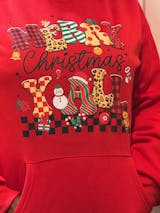New DTF Gang Sheet Builder
Thank you, Ericka! We appreciate the review on our New DTF Gang Sheet Builder. If there’s anything we can improve to earn that last star—layout help, file checks, or quick resizing—just let us know. We’re happy to optimize your next sheet and make it perfect!
Transfers were received - timely shipping, packaged well and great color. East to apply and provides a great product for t-shirt, sweatshirt, etc. When I submitted my own file, I love the fact that Customer Service reached out to ensure about image. Printing of image was great. I also love that they offer images ready for you to purchase in their library, such as the image which is pictured here. Great transfers for great products. Definitely recommend for products and customer service. Thank you again!
Gwendolyn, this made our day! 🙌 Thanks for calling out the quick shipping, file check, and library designs. We’re thrilled the color and press went great. If you ever want a pre-press check or sizing tweak before your next order, just drop the file in—we’re happy to help every time!
New DTF Gang Sheet Builder
Thank you, Lisa! Glad you tried the New DTF Gang Sheet Builder. If you want us to double-check layout, stroke weights, or press notes before your next sheet, we’ll review it free and make sure it’s perfect.
Love this DTF! Great colors! I love most of all what it says. I will be a returning customer
Appreciate you, Kel! Stoked that the colors and finish hit the mark. We’d love to help on the next run—if you have target garment colors or a specific finish in mind, tell us and we’ll tune the print for it.
Happy with my product!
Thanks so much, Marcia! 😊 Happy to hear you’re happy. If you need any heat-press tips or a quick file check for your next order, just message us—we’re here for you!










